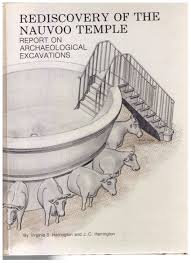Articles/Essays – Volume 07, No. 1
Archaeology in Nauvoo | Virginia S. Harrington and J. C. Harrington, Rediscovery of the Nauvoo Temple
Rarely is a report on an archaeological excavation so handsomely designed and mounted, but equally rare is a site whose history is as remarkable as that of the Mormon Temple at Nauvoo, Illinois. Built in the grand manner between 1841 and 1846, the massive structure was barely completed before its congregation had moved away, leaving the building to be gutted by fire in 1848 and to be felled by a tornado two years later. Here, then, was a monument to the industry of the members of The Church of Jesus Christ of Latter-day Saints, but one whose contribution to Mormon life and history ended almost before it had begun.
The ruins were first cleaned out by the French Icarians who attempted to convert the basement to their own use, but who gave up after the tornado; then, along with other settlers, they proceeded to carry away the building materials for use elsewhere. Out of this relatively unpromising site, Virginia and Jean C. Harrington have been able to fashion an engrossing and yet scholarly book. Realizing that the contents may be more interesting to members of the Mormon Church than to archaeologists (there being few artifacts and no likelihood of unearthing another Mormon Temple like it), Mrs. Harrington has very properly concentrated on telling the history of the building and describing what they found of it, leaving her husband’s account of “Archaeological Procedures” and his clear but, to the layman, possibly intimidating sectional drawings to hide as appendices at the back. Mr. Harrington has also supplied a useful bibliography of their sources and a thoroughly workmanlike index.
Those of us who are concerned about the ever climbing cost of printing and who question the usefulness of publishing archaeological reports that are of little value to colleagues not concerned with that particular site contend that too many excavators print material that could just as well remain in manuscript in an appropriate archival repository. Archaeologists are taught, however, that publication is the essential end-product of any excavation—even if it only serves to cleanse the director’s conscience and to expand his vita and thus his market value. The Harringtons, of course, need no such buttress, for Mr. Harrington is internationally recognized as the pioneer of historical archaeology in the United States, who, throughout his career, has been a vociferous champion of an historian’s approach to the buried remains of America’s European past. Although this publication may at first glance appear to be of little practical use to historical archaeologists, it has, in fact, a great deal to teach us. The volume is a model of clarity, demonstrating just how such a report should be organized, showing how it can be presented to make the medicine easy to swallow, and above all sounding the humbling warning that one picture can be worth a thousand stones.
There are, in fact, two contemporary pictures of the temple (a daguerreotype of c.1846-48 and a tintype of 1850) plus an 1848 sketch of its tremendous baptismal font. The excavations yielded a few leg and sculptured hair fragments from the font’s twelve supporting oxen, plus pieces of its dressed stone; although valuable details to aid in any eventual reconstruction, they were not enough to reconstruct or even identify the font had its existence not been known from documentary sources. Similarly, although the digging revealed the basement ground plan, it would have been a rash director who would have attempted any kind of artist’s reconstruction based on such slender evidence. It is the comparison between the daguerreotype and the ground plan that provides the real archaeological lesson of the Nauvoo Temple, and it is one that can usefully be pondered by every archaeologist who tries to interpret the robbed remains of masonry buildings of any culture or period without the benefit of contemporary illustrations or descriptions to show what those buildings were really like.
Apart from a minor quibble involving the need for the identification on the master plan of photo angles and the lines of drawn sections illustrated in the report, my only major complaint probably belongs at the door of the Nauvoo Restoration rather than at that of Mr. and Mrs. Harrington. Their otherwise admirably produced book is marred by the inclusion of a modern frontispiece painting of the temple based on “drawings and plans of William Weeks,” the temple architect. This flat, calendar-art reconstruction is out of character with the design and scholarship of the rest of the book and manages to make the building seem infinitely less impressive than it does in the contemporary daguerreotype. More importantly, it may lead the reader to suppose that the report will deal with the superstructural evidence upon which the artist’s reconstruction is based, whereas, in fact, it is concerned almost exclusively with the below-ground appearance and layout of the building. One can but hope that so fine a record of an important piece of work will be sufficiently well received to merit a speedy second printing — omitting the frontispiece paint ing in favor of the original photograph (now Figure 1) or of using William Weeks’ plans, which in this edition are referred to but not illustrated.
Rediscovery of the Nauvoo Temple. By Virginia S. Harrington and J. C. Harrington. Salt Lake City, Nauvoo Restoration publication, 1971. 54 pages, 32 illustrations.


 Back to full Issue
Back to full Issue

